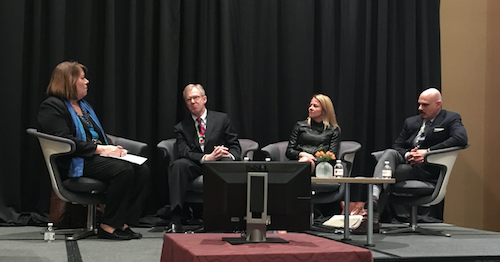
Senior living, real estate management and banking professionals shared their thoughts on design, service and financing trends March 9 during a National Investment Center for Seniors Housing & Care 2016 Spring Investment Forum session moderated by NIC’s chief economist, Beth Mace.
Christopher Kazantis, director of AEW Capital Management, noted that many properties built 15 or 20 years ago don’t meet the desires of those looking for seniors housing today. To be competitive, properties now need to have larger common areas, multiple dining areas, and individual units that are bigger and have more storage space. Some owners can’t or don’t want to update their communities.
“I think a lot of this older product … is going to turn into the affordable product, because the only way they’re going to be able to compete is on price,” he said.
Standing out in the market
Lori Alford, chief operating officer of Avanti Senior Living, said her company tries to differentiate itself by building communities that are unlike other properties in the markets it serves. “If you’re going to go out and build a brand new building, and it’s just going to be the same design as 10 years ago, that shiny, new penny is not going to get you very far,” she said, especially if the competitor has a good reputation.
Avanti communities feature dining areas that function more as restaurants rather than dining rooms, art rooms that are not simply converted former residents’ rooms, mind/body/strength areas that offer massage and other spa-type services, and fitness areas that offer yoga, barre and strength classes. And the communities don’t have activity rooms.
“You don’t have to design a lot of spaces. It’s really about the programming,” she said. For example, faculty from a local community college teach art and other classes.
The properties, Alford added, have a boutique feel, with blown glass decorations and executive team members wearing all black. It may seem expensive, but the communities do not have the highest rates in the market, she said.
Residents are very pleased with the changes, Alford said — and so are their adult children. During focus groups, she added, adult children have said: “I would live here, I’m proud that my mom lives here, and, more importantly, we love coming here.”
“We just started with a clean slate and said, ‘Who do we want to sell to, who do we want to serve and who do we want to employ?’ Let’s create a building that’s built for them, that’s designed for them and that appeals to them,” Alford said. “It’s served us well, and we have captured market share because of it.” In fact, she added, more than 50% of move-ins and deposits are from existing competition.
New models, new funding
William Shine, senior director at Synovus Bank, said a future trend will be a hybrid model of senior housing and care that combines assisted living and skilled nursing. Such a model will be easier to implement in states such as Texas and Florida, which have no certificate of need requirements, he added.
Kazantis predicted that every major core fund will have a senior living component within 10 years. “A lot of these huge core funds that have only invested in the traditional asset classes — office, multifamily, retail, industrial — they, like the lenders and everyone else, are really looking for yield, and they’re looking for assets that can throw off cash,” he said. “Stabilized senior housing hit both of those in spades. …So you’re going to start to see a lot of these big core funds start to come into the sector and replace the real estate investment trusts and start buying that asset class.”
Kazantis also cautioned potential senior living investors and operators to be sure their motives are pure. “Anyone who is out there and thinking of getting into the industry, make sure you’re getting into the industry because you really have a mission and you really care about taking care of seniors and seniors’ families,” he said. “If that’s what your ultimate goal is, then you have to run it like a business — dollars and cents and bottom line — but if that’s your goal, you’ll probably be successful.” Those who enter the market just looking to make money probably will not be successful in the long run, he said.
Most of the pioneers of the industry started in the business because they didn’t like what they saw when they were looking for living arrangements for their aging parents, Kazantis said.
The NIC event runs through Friday in Dallas.



